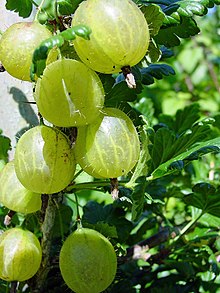Ribes uva-crispa
Ribes uva-crispa, the European gooseberry or gooseberry, is a shrub native to Europe, northwestern Africa and southwestern Asia Minor; it belongs to the subgenus Grossularia, sometimes treated as a separate genus within Ribes, comprising the different hirsute species of currant bushes. The American gooseberry, Ribes hirtellum, is closely related, and easy to mistake on sight; both have thorny stems and have isolated terminal flowers, in pairs or trios, not in clusters.
Description
Shrub between 1 and 3 m tall, densely branched and covered with thorns; the leaves are trilobed or five-lobed, deeply crenate, with well marked veins. The flowers are bell-shaped, axillary, arise solitary or in pairs, pedunculated. The fruit is an edible false berry that is hairy in appearance and usually green in color, although red and dark purple variants occasionally occur.
Distribution and habitat
The gooseberry is native to Europe and Southwest Asia. It grows spontaneously in alpine areas and wooded rocky areas in the southernmost areas, from eastern France to the Himalayas and peninsular India. In Great Britain it is often found in copses or forming hedges, but it has been cultivated for so long that it is difficult to distinguish wild from cultivated species or whether it can be considered as native flora of the island. It is also common on the lower slopes of the Piedmontese Alps and Savoy, and it is not known with certainty if the Romans already knew about it, although it is believed that Pliny the Elder made a vague allusion to it in a passage of his work Naturalis Historia.
Cultivation
Needs soil moisture, does not tolerate droughts or excessive summer temperatures. The winter cold, without extreme frosts, is necessary for good fruiting. It can be propagated by seed, but growth is slow the first few years. It is quickest to propagate fruit varieties by cuttings planted in autumn; they root quickly and in a few years form good fruit bushes. In this way, the characteristics of the parent are also faithfully reproduced. The flowers appear in the terminal buds of the stems of the previous year, therefore, the branches should not be shortened in winter. To avoid excessive development in length of the basal shoots, they must be pinched in summer, when they are still tender. This forces the formation of flower buds and prevents them from elongating excessively, something that is not recommended, due to its fragility. The oldest trunks gradually lose their vitality, so it is advisable to cut them when fruit production declines. Through correct pruning, the staggering of fruiting between the new shoots and the oldest ones is allowed, and aging and entanglement due to natural growth are avoided.
Uses
Currants are well known in the making of desserts such as cakes, smoothies and crumbles. They are usually preserved dry, in sugary syrup, as jam or pickles. They are also used to flavor drinks and liquors or to make fruit wine.
Taxonomy
Ribes uva-crispa was described by Carlos Linnaeus and published in Species Plantarum 1: 201. 1753.
- Etymology
Ríbes: generic name that seems to come from the Arabic rabas; in Persian rawas and rawash = name in the East of a rhubarb (Rheum ribes L., polygonáceas). It is claimed that ribes appears for the first time in the West in the translation that Simón Januensis made, in the second half of the century XIII, from the book of Ibn Sarab or Serapion –Liber Serapionis aggregatus in medicinis simplicibus...– and that this name was adopted by pharmacies. In any case, it was applied to different plants, which are the currants (Ribes sp. pl.), perhaps because of their acidic fruits and their similar medicinal properties.
uva-crispa: Latin epithet
- Sinonimia
|
Common name
- spanish, spanish, spanish
Contenido relacionado
Fumaria capreolata
Teligonaceae
Lophopogon



